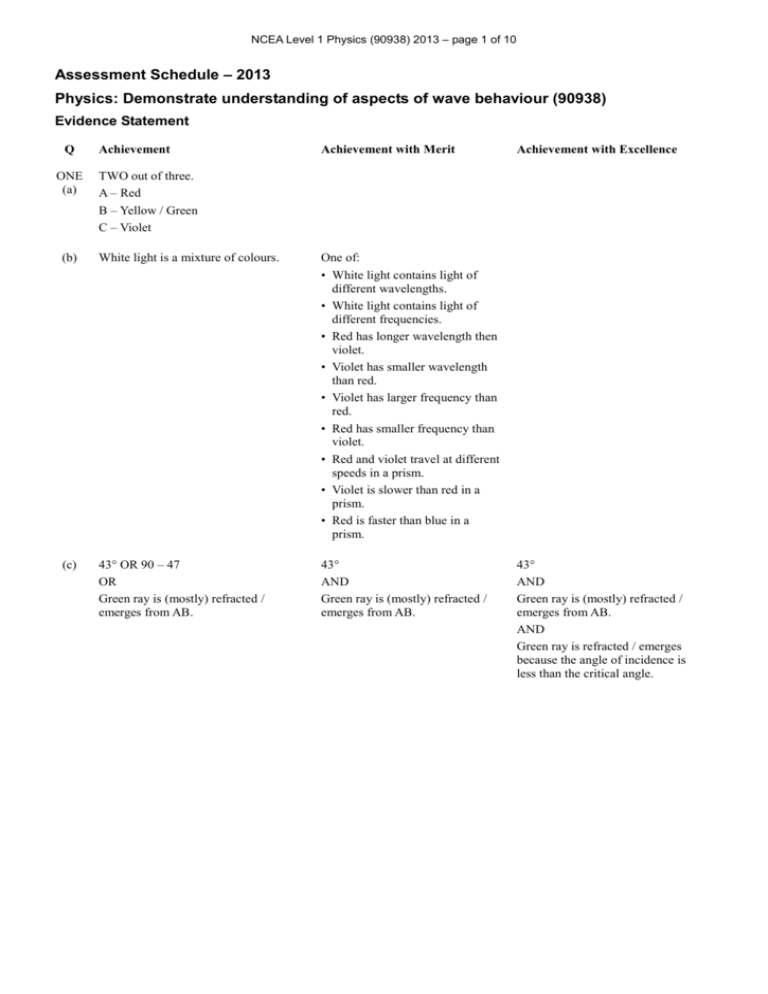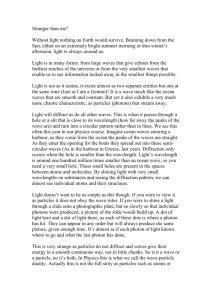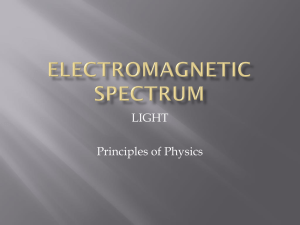NCEA Level 1 Physics (90938) 2013 Assessment Schedule
advertisement

NCEA Level 1 Physics (90938) 2013 – page 1 of 10 Assessment Schedule – 2013 Physics: Demonstrate understanding of aspects of wave behaviour (90938) Evidence Statement Q ONE (a) Achievement Achievement with Merit Achievement with Excellence TWO out of three. A – Red B – Yellow / Green C – Violet (b) White light is a mixture of colours. One of: • White light contains light of different wavelengths. • White light contains light of different frequencies. • Red has longer wavelength then violet. • Violet has smaller wavelength than red. • Violet has larger frequency than red. • Red has smaller frequency than violet. • Red and violet travel at different speeds in a prism. • Violet is slower than red in a prism. • Red is faster than blue in a prism. (c) 43° OR 90 – 47 OR Green ray is (mostly) refracted / emerges from AB. 43° AND Green ray is (mostly) refracted / emerges from AB. 43° AND Green ray is (mostly) refracted / emerges from AB. AND Green ray is refracted / emerges because the angle of incidence is less than the critical angle. NCEA Level 1 Physics (90938) 2013 – page 2 of 10 (d) One similarity: • Both are a part of the (electromagnetic) spectrum. • Both are components of white light. • Both orange and blue light are electromagnetic waves. • Travel at same speed in a vacuum. OR One difference: • different frequency • different wavelength • different energy • different speeds in a prism • blue refracted more than orange in a prism. One similarity: • Both are a part of the (electromagnetic) spectrum. • Both are components of white light. • Both orange and blue light are electromagnetic waves. • Travel at same speed in a vacuum. AND One difference: • different frequency • different wavelength • different energy • different speeds in a prism • blue refracted more than orange in a prism One similarity explained: Both orange and blue light travel at the same speed (in vacuum) because they are electromagnetic waves. OR One difference explained: They are different colours because they have different frequency / wavelength. Orange and blue light refract by different amounts when they enter / leave less dense / rarer / more dense mediums because they have different frequency / wavelength. (Blue refracts more than orange.) Orange and blue light travel at different speeds inside the prism/ any medium apart from a vacuum because they have different frequency / wavelength. (Orange travels faster than blue.) Orange and blue light carry different amounts of energy because they have different frequency / wavelength. (Blue carries more energy than orange.) NØ N1 N2 A3 A4 M5 M6 E7 E8 1a 2a 3a 4a 2m 3m 1e 2e NCEA Level 1 Physics (90938) 2013 – page 3 of 10 Q TWO (a) Achievement Achievement with Merit Period is the time for one wave to pass a point OR Period is the time for one wave to pass a point AND T= (b) 5 = 0.5 s 10 (units not required) Correctly calculates v: v= (c) 4.8 = 0.40 (m s –1 ) 1.2 NØ v= fl so l = States that waves diffract / bend around the wall. OR Diagram showing diffraction of waves at the edge of the barrier but wavelength not kept the same/bending not occurring at correct position. v f 4.8 = 0.40 m s -1 12 9 f = = 0.60 Hz 15 0.40 l= = 0.667 m 0.60 = 0.7 m or 0.6 recurring v= 9 = 0.60 (Hz) 15 Explains that the wave fronts / crests curve at the edge of the wall and travel with the same speed / have the same wavelength. OR A correct diagram showing diffraction of waves at the edge of the barrier with no change in wavelength. (Appendix A) (Appendix A) (d) 5 = 0.5 s 10 (units not required) Correctly calculates one of v or f AND correct method for other calculation. OR Correctly calculates λ with no or incorrect unit. OR Correctly calculates f: f = T= Achievement with Excellence States less diffraction / bends around the wall less(as much as they pass the edge). OR Shorter wavelength / waves closer together. The waves will have a shorter wavelength / the wave crests are closer together, because the frequency is higher (and speed the same). OR The waves will diffract less because the wavelength is less (as much as they pass the edge). Waves at higher frequency will have shorter wavelength (if the speed is the same) AND When the wavelength is shorter the amount of diffraction is less, so these waves will not diffract as much as they pass the edge. (Must discuss of “edge” not “gap”) N1 N2 A3 A4 M5 M6 E7 E8 1a 2a 3a 4a 2m 3m 1e 2e NCEA Level 1 Physics (90938) 2013 – page 4 of 10 Q THREE (a) (b) Achievement Achievement with Merit States ONE difference. • Radio waves are transverse waves while sound waves are longitudinal. • Sound waves require a medium while radio waves do not require a medium. • Radio waves travel faster than the sound waves. • Radio waves are electromagnetic waves and sound waves are mechanical waves. • We can’t hear radio waves but we can hear sound waves (Difference may be implied, eg: Radio waves are electromagnetic waves and sound waves are no.t) States TWO differences. • Radio waves are transverse waves while sound waves are longitudinal. • Sound waves require a medium while radio waves do not require a medium. • Radio waves travel faster than the sound waves. • Radio waves are electromagnetic waves and sound waves are mechanical waves. • We can’t hear radio waves but we can hear sound waves. (Difference must be implicit, eg Radio waves are electromagnetic waves and sound waves are mechanical waves.) Achievement with Excellence Correct working for: v = f λ = 800 0.41(= 328 m s–1) OR v = f λ = 800 41/100 (= 328 m s–1) OR Calculates 32800 cm s–1 and shows working which converts to m s–1 (= 328 m s–1) (c) Calculates the time for sound wave: d 180 = = 0.5487 s v 328 (or 0.55 s) t= (units not required) (If then multiplies by 2 - without stating any assumptions- does not negate the award of A) Echo / “There and back” cannot be accepted. Calculates the time for sound wave: d 180 = = 0.5487 s v 328 (or 0.55 s) Calculates the time for sound wave: d 180 = = 0.5487 s v 328 (or 0.55 s) t= t= (units not required) AND (Incorrectly) states that they have assumed the speed of the radio wave is the same as the speed of sound. AND Calculates time of 1.1 s. (units required) AND States one of: • The actual time is slightly more than the calculated value. • Radio waves arrive immediately etc. • Time for radio wave to travel 180 m is insignificant/can be ignored. • States that the time is 0.5487 s plus the time for the radio waves to travel to the boat. • Calculates time that radio wave takes to travel using speed of light and adds this. NCEA Level 1 Physics (90938) 2013 – page 5 of 10 (d) NØ The air particles vibrate OR Longitudinal wave. The air particles vibrate. AND Air particles hit/pass energy to the adjacent particles causing them to vibrate/Create compressions and rarefactions in air. The air particles vibrate parallel to wave movement AND Air particles pass hit/pass energy to the adjacent particles causing them to vibrate/Create compressions and rarefactions in air. N1 N2 A3 A4 M5 M6 E7 E8 1a 2a 3a 4a 2m 3m 1e 2e NCEA Level 1 Physics (90938) 2013 – page 6 of 10 Q FOUR (a) Achievement Achievement with Merit Achievement with Excellence TWO of three: • Wavelength correctly shown • Amplitude correctly shown. THREE of three: • Wavelength correctly shown • Amplitude correctly shown. • Motion correctly described as one of: - Up and down - Perpendicular - At right angles to wave (movement) - Transverse • Motion correctly described as one of: - Up and down - Perpendicular - At right angles to wave (movement) - Transverse (Appendix B) Image is located correctly OR ONE ray is drawn correctly with: • at least ONE correct arrow • a virtual ray (arrows on virtual rays are neutral, dotted lines for virtual rays are neutral) • Image location as point of origin for virtual ray • Reflected ray going into eye. (Appendix B) Image is located correctly AND ONE ray is drawn correctly with: • both arrows correct • virtual ray (arrows on virtual rays are neutral, dotted lines for virtual rays are neutral) • image location as point of origin for virtual ray • reflected ray going into eye (Appendix B) Image is located correctly AND TWO rays are drawn correctly with: • both arrows correct • virtual ray (without arrows AND with dotted lines) • image location as point of origin for virtual ray • reflected ray going into eye. (Whether image is labelled or not/image is drawn well or not has been ignored.) OR TWO rays are drawn correctly with BOTH arrows correct and includes virtual rays (without arrows) with image location as point of origin for virtual ray. BUT image is incorrectly located. (Whether image is labelled or not/image is drawn well or not has been ignored.) (Whether image is labelled or not/image is drawn well or not has been ignored.) (b) NCEA Level 1 Physics (90938) 2013 – page 7 of 10 (c) Conclusion that he cannot see his feet. AND ONE of: • Attempts to draw ray to show / attempts to explain that he cannot see his feet because ray from feet misses his eyes. • Attempts to draw ray to show / attempts to explain that he can only see just below his knee because this is the lowest point that a ray of light can come from, hit the bottom of the glass, and be reflected into his eye. • Attempts to draw ray to show / attempts to explain where the glass would need to be in order for him to see his feet Conclusion that he cannot see his feet. AND ONE of: • Ray drawn to show / explains that he cannot see his feet because ray from feet misses his eyes. Conclusion that he cannot see his feet. AND ONE of: • Ray drawn to show / explains that he cannot see his feet because ray from feet misses his head. (Appendix C) BUT no arrows/reflection not at bottom of glass (wrong arrows neutral) • Ray drawn to show/explains that he can only see just below his knee because this is the lowest point that a ray of light can come from, hit the bottom of the glass, and be reflected into his eye. (Appendix C) With arrows and reflection close to bottom of glass / explanation that angle of incidence = angle of relection • Ray drawn to show / explains that he can only see just below his knee because this is the lowest point that a ray of light can come from, hit the bottom of the glass, and be reflected into his eye. (Appendix D) BUT no arrows/reflection not at bottom of glass (wrong arrows neutral) • Ray drawn to show/explains where the glass would need to be in order for him to see his feet (Appendix D) With arrows and reflection close to bottom of glass/explanation that angle of incidence = angle of relection • Ray drawn to show/explains where the glass would need to be in order for him to see his feet (Appendix E) BUT no arrows / reflection not at approximately 0.875 m (wrong arrows neutral) • Statement that (part of) the glass needs to be positioned half way between eyes and feet to see feet. (Appendix E) With arrows and reflection close to approximately 0.875 m. • Statement that (part of) the glass needs to be positioned half way between eyes and feet to see feet which is 0.875 m from ground. • Uses protractor to measure angles and draws diagram to show ray missing eye. NCEA Level 1 Physics (90938) 2013 – page 8 of 10 (d) Correct ray diagram (arrows and normals not required). OR Refraction . OR Light slows down in the glass . OR Bends towards the normal. NØ Correct ray diagram (arrows and normals not required). AND Refraction . AND Light slows down in the glass. N1 N2 A3 A4 M5 M6 E7 E8 1a 2a 3a 4a 2m 3m 1e 2e Judgement Statement Score range Not Achieved Achievement Achievement with Merit Achievement with Excellence 0–9 10 – 18 19 – 25 26 – 32 NCEA Level 1 Physics (90938) 2013 – page 9 of 10 Appendix A: Appendix B: Appendix C: NCEA Level 1 Physics (90938) 2013 – page 10 of 10 Appendix D: Appendix E:







